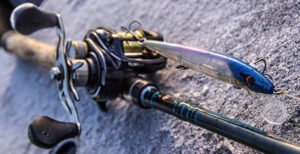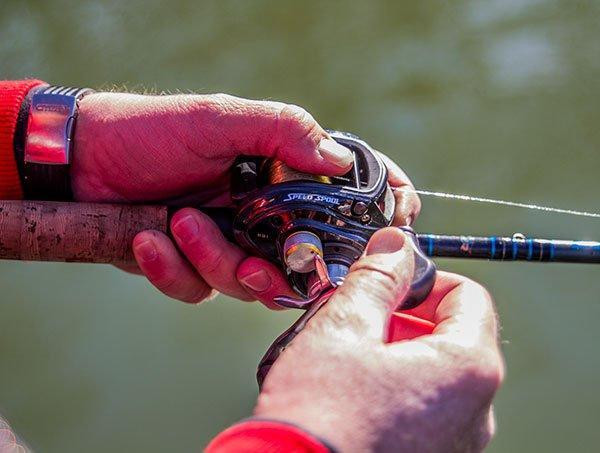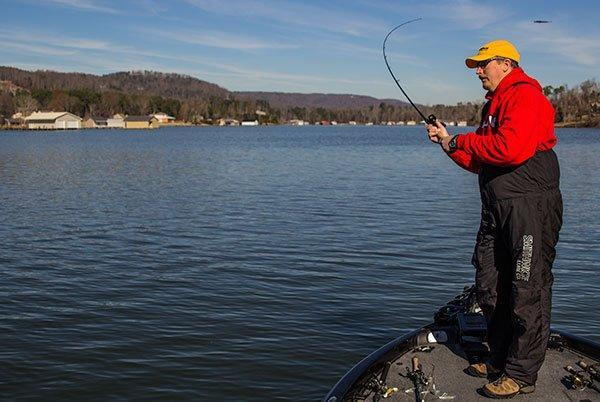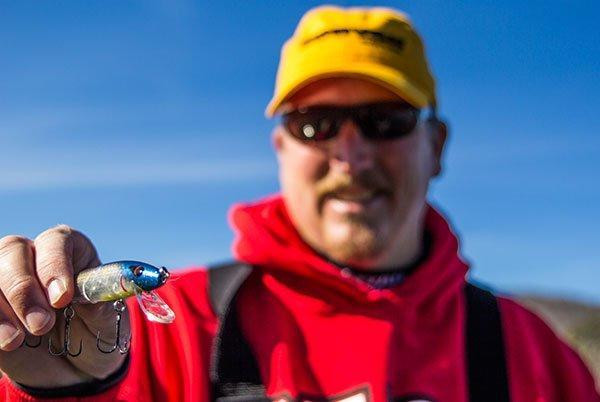Jerkbait fishing is an excellent way to catch big bass throughout the winter months. Your fingers may get numb and you might have icicles hanging from your nose, but the bass still have to eat. Before you let the cold weather scare you away from your favorite fishery, try this overlooked technique for some incredible coldwater bass fishing action.
BASS Opens pro and Alabama guide Jimmy Mason is widely renowned as an authority on coldwater jerkbait fishing. When the winter weather is at its worst, you’ll see him catching some of his biggest bass of the year.
Throughout his career, he’s developed 8 coldwater jerkbait tips that many anglers tend to overlook. Utilizing this advice can result in some unforgettable days of winter bass fishing.
1. Know what you’re imitating
Shad can have a hard time acclimating to drastic changes in temperature. Whenever the water temperature drops into the 40-degree range, you’ll notice thousands of dying shad floating on or just under the surface. These shad kills represent easy, protein-rich meals for hungry bass.
“When you notice a shad kill happening, you can bet they’ll be a solid jerkbait bite somewhere nearby,” Mason said. “As they’re dying, they quiver on or near the surface before sinking to the bottom. A jerkbait just sitting there, moving with the current is a perfect imitation of this natural occurrence.”
In order to add a bit more realism to his jerkbait presentation, Mason does something that may look a little odd, but has proven effective time after time.
“When my jerkbait is paused, I’ll just barely tap my rod with my reel handle hand,” Mason said. “Even though I’m not hitting it very hard, it puts a lot of extra quiver into the lure, which has resulted in hundreds of extra fish catches for me over the years.”
2. Length of pause is crucial
Fishing a jerkbait in cold water takes a lot of self-discipline. We get so accustomed to our normal “cast, retrieve, repeat” cadence that we sometimes forget to match our presentation to the mood of the bass. As the water temperature decreases this time of year, bass become very lethargic—their metabolism slows down and they’re much less likely to aggressively pursue forage. Forcing yourself to slow down is imperative to increasing your success.
“The biggest key to winter jerkbait fishing is the length of your pauses,” Mason said. “It’s very important to use a counting method when pausing the lure. The closer the fish bite to my predetermined count, the higher I’m going to count on subsequent casts. When a bass hits it on the pause, it’s going to feel similar to a worm bite—just a few ticks and your line will slowly swim off.”
Mason’s favorite coldwater jerkbaits:
- Targeting shallower bass: Smithwick Suspending Rattlin Rogue
- Targeting deeper or bigger bass: Smithwick Perfect 10 Rogue
It’s important to have a solid starting point when implementing the counting method. Mason uses the following guidelines to determine his length of pause while making small adjustments in accordance to the bass’ behavior.
- Lower 50s – “Bass are still fairly active when the water is in the 50-degree range, so I like to start with a three-count in this temperature range,” Mason said. “If I’m not getting any bites, I may increase to a five-count.”
- Mid to upper 40s – “You’ll still find some active bass in this temperature range, but this is when longer pauses will really begin to pay off,” Mason said. “I’ll start with a five or seven-count and let the fish dictate where I go from there.”
- Lower 40s – “When the water is in the lower 40s, it’s very important to make yourself slow way down,” Mason said. “I’ll begin the day with a 10-count in the morning and go from there. There have been days I’ve had to pause my jerkbait for an entire 15 seconds between jerks, but that’s about as long as I’ll go.”
3. Line type depends on your preferred presentation
You’ll hear a lot of jerkbait aficionados swear by very specific line types but that isn’t the case with Mason. He’s a big believer in changing his line type in accordance to his desired suspension rate and the environmental conditions.
“I use a combination of line when I’m jerking,” Mason said. “It’s pretty even split between Vicious Ultimate Co-Polymer and Vicious Pro Elite Fluorocarbon. If I want my jerkbait to reach its maximum depth when targeting deeper fish, I’ll choose fluorocarbon line because it sinks. When I’m catching them on a longer pause and the fish are very inactive, I want to use copolymer because its flotation properties allow my jerkbait to suspend better.”
Believe it or not, the weather actually plays an important role in his line selection as well. Regardless of your preferred brand, all fluorocarbon becomes much stiffer and more difficult to manage in really cold weather. When the air temperature drops to the 32-degree mark, Mason tends to lean towards copolymer line.
“Manageability is a big deal, especially in cold weather,” Mason said. “It’s already tough enough to cast with cold fingers, so I want to use a limper line to increase my efficiency. Jerkbait fishing is an integral part of my winter strategy, so I’ll keep four jerkbait rods on my front deck—two rigged with each type of line so I can switch easily.”
4. Feed it slack between jerks
Your jerkbait fishing success is largely dependent upon the action of your rod tip. Don’t let a jerkbait’s bill fool you—you don’t want to retrieve it like you would a crankbait. Your reel should only be used for taking up slack line.
“It’s important to twitch a jerkbait with slack in your line,” Mason said. “Before you make that next jerk, put your rod tip six inches toward the bait to create some additional slack. If you jerk on a tight line, you’re limiting the lure to about 60 degrees of total range from center-pull. When you jerk on a slack line, however, you’re increasing its range to almost 90 degrees. This erratic action is what makes the fish attack it.”
Recommended gear:
- Casting rod: 704CB Dobyns Champion Cranking Rod
- Spinning rod: 703SF Dobyns Champion Spinning Rod
- Casting reel: 6.4:1 Lew’s BB-1 Speed Spool Casting Reel
- Spinning reel: 3000 model Lew’s Team Gold Carbon Spinning Reel 3000 series
Working your jerkbait on slack line is also beneficial when you consider the sluggish mood of wintertime bass. If the lure is moving too far forward when you jerk, you’re probably discouraging nearby bass from biting.
“Coldwater bass don’t want to move much to eat,” Mason said. “You also need to consider that you’re imitating a dying shad—they don’t dart around very much. Sometimes a cast will take me four minutes to complete and it’s because I’m always working that jerkbait on a slack line, keeping it in the strike zone for as long as possible.”
5. Make an effort to find vertical drops
Because winter fishing is so dependent upon the mood of the bass, Mason suggests fishing your jerkbait around any type of vertical drops, such as creek and river channels. These bass prefer to hang out in deep water but want the option to quickly move shallow to feed if necessary. Vertical drops give them the best of both worlds.
“As the fall progresses into the winter, they’re going to transition to vertical drops,” Mason said. “I always look for channel swings near a bluff wall or channel swings near a big flat. These areas allow them to sit in deeper water and move to shallower water without exerting too much effort.”
When looking for suitable water to target, Mason keeps his eyes glued to his Humminbird units. The presence of bait is especially important in the winter months, so wherever you find bait, you’ll usually find bass.
“Very rarely will I fish an area without seeing bait on the graph,” Mason said. “I may fish a good looking void of bait for a few minutes, but I’m going to fish much harder and longer is bait is present.”
6. Focus on windy banks
Most of us have heard it before—always chase the wind with a jerkbait. There’s no denying its effectiveness, but why is the wind such a big deal? It actually doesn’t have anything to do with bass or bait positioning.
“Windier areas are always more productive for me when I’m jerkbait fishing,” Mason said. “Windblown points or banks are always my first choice. In my opinion, it breaks up the sunlight and makes it much harder for the bass to distinguish between your jerkbait and the real thing. The water is usually fairly clear throughout the winter, so the wind makes it much easier to fool these finicky bass.”
In regards to water clarity, Mason requires at least 18 inches of visibility in order to effectively fish a jerkbait. While some bass fishing presentations rely on water displacement or vibration, jerkbait fishing is a very visual technique.
7. Check out the sky before choosing a color
With thousands of different lure colors on the market, it’s very easy to get caught up in your color selection process. Instead of focusing on the number of purplish-blue glitter flakes a jerkbait has on its back, Mason prefers to keep everything simple.
“In clear conditions, I have much more success on metallic and translucent colors,” Mason said. These are the days on which a bass’ vision is excellent, so it’s important to use the most natural colors you possibly can. When it’s cloudy or I’m fishing in lightly stained water, I prefer using matte colors in order to give the bait a better silhouette. The only exception is a gold jerkbait—it has outstanding flash in cloudy conditions.”
8. Jerkbait fishing isn’t just an open water technique
Now it’s probably not a great idea to throw your favorite jerkbait directly into a laydown, but fishing it around cover is an outstanding idea when fishing throughout the winter. Cover holds heat, so it’s not at all uncommon to find big bass buried underneath cover such as docks, laydowns or brush piles.
“You can have some awesome days jerking parallel to deeper docks in 15 to 25 feet of water,” Mason said. “Never be afraid to throw your jerkbait toward visible cover. It’s not going to be like banging a squarebill around—instead, you’re trying to draw the fish away from the cover. If you throw just over it or to the side, you’ll catch some true giants.”
Mason primarily jerks his rod tip downward when fishing a jerkbait, but he’ll make an occasional concession when he’s around cover. If your jerkbait is running a bit too deep, he suggests making occasional upward jerks in order to bring the lure higher in the water column.
I’ve heard a lot of folks say that bass anglers are crazy—they might actually be right. When the weather turns nasty and there’s not another soul on the lake, throw some extra clothes on and head to your favorite fishery. If you can make yourself stick with a jerkbait all day and practice these tips, there’s a great chance you’ll catch some great bass.
















